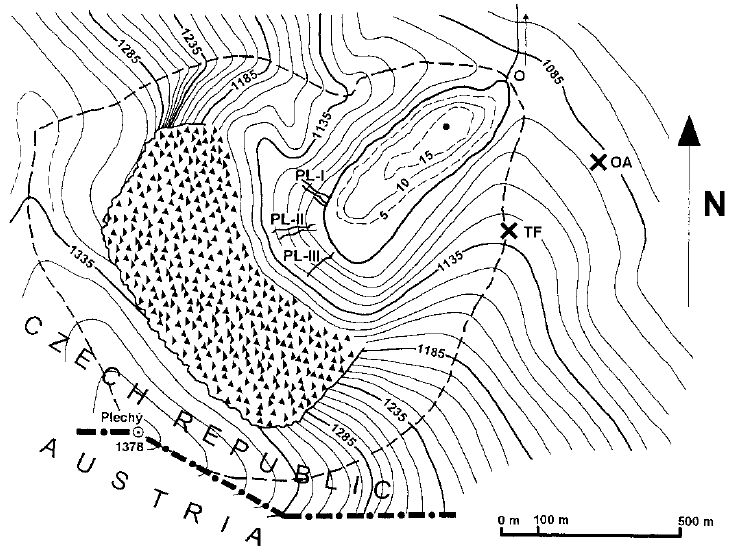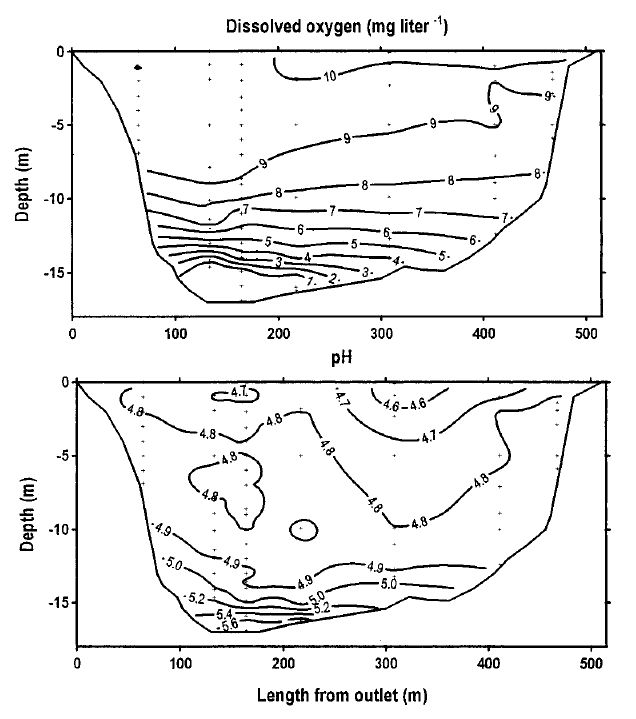 Acid precipitation has been shown to reduce phosphorus (P) outputs from terrestrial sources. We present field evidence that the in-lake P cycle may also be disrupted in atmospherically acidified watershed-lake ecosystems. Plešné Lake in the Bohemian Forest is an acidified forest lake with epilimnetic pH of 4.5-4.9, total P concentration of ~10 µg L-1, and pronounced anoxia above the bottom during winter and summer stratification periods. The water chemistry of the anoxic zone develops in a predictable way: After depletion of dissolved oxygen, concentrations of nitrate and sulfate decrease while concentrations of ammonium, iron, alkalinity, and pH increase; the only exception to the general pattern is a permanently low concentration of dissolved reactive P (<1 µg L-1) above the sediment. This in-lake P inactivation can be explained by the acidification of soils in the watershed and subsequent precipitation of Al in the lake. The suggested mechanism is as follows: atmospheric deposition of strong acids has resulted in strong acidification and nitrogen saturation of soils in the Plešné Lake watershed and, consequently, in high terrestrial losses of Al (0.78-1.04 mg L-1), SO42- (4.5-7.7 mg L-1), and NO3– (0.48-1.15 mg L-1 NO3 -N) to the lake. Biological removal of NO3– and SO42- by both assimilatory and dissimilatory reduction contributes greatly to the total in-lake alkalinity generation and to the increase in water pH. Under higher pH, ionic Al species hydrolyze and form colloidal Al hydroxides (Alpart ), which coagulate dissolved organic carbon and adsorb orthophosphate in the water column. The Al hydroxides settle and increase the P sorption capacity of the sediment. The elevated content of fresh Al oxyhydroxides in the surface sediment reduces P release to the water column after orthophosphate liberation from ferric oxyhydroxides during anoxia, because Alpart complexes are not sensitive to redox changes. The example of Plešné Lake shows that atmospheric acidification of a watershed-lake ecosystem may provide the natural conditions for in-lake P inactivation similar to the lake restoration technique based on the artificial addition of Al salt to the water column.
Acid precipitation has been shown to reduce phosphorus (P) outputs from terrestrial sources. We present field evidence that the in-lake P cycle may also be disrupted in atmospherically acidified watershed-lake ecosystems. Plešné Lake in the Bohemian Forest is an acidified forest lake with epilimnetic pH of 4.5-4.9, total P concentration of ~10 µg L-1, and pronounced anoxia above the bottom during winter and summer stratification periods. The water chemistry of the anoxic zone develops in a predictable way: After depletion of dissolved oxygen, concentrations of nitrate and sulfate decrease while concentrations of ammonium, iron, alkalinity, and pH increase; the only exception to the general pattern is a permanently low concentration of dissolved reactive P (<1 µg L-1) above the sediment. This in-lake P inactivation can be explained by the acidification of soils in the watershed and subsequent precipitation of Al in the lake. The suggested mechanism is as follows: atmospheric deposition of strong acids has resulted in strong acidification and nitrogen saturation of soils in the Plešné Lake watershed and, consequently, in high terrestrial losses of Al (0.78-1.04 mg L-1), SO42- (4.5-7.7 mg L-1), and NO3– (0.48-1.15 mg L-1 NO3 -N) to the lake. Biological removal of NO3– and SO42- by both assimilatory and dissimilatory reduction contributes greatly to the total in-lake alkalinity generation and to the increase in water pH. Under higher pH, ionic Al species hydrolyze and form colloidal Al hydroxides (Alpart ), which coagulate dissolved organic carbon and adsorb orthophosphate in the water column. The Al hydroxides settle and increase the P sorption capacity of the sediment. The elevated content of fresh Al oxyhydroxides in the surface sediment reduces P release to the water column after orthophosphate liberation from ferric oxyhydroxides during anoxia, because Alpart complexes are not sensitive to redox changes. The example of Plešné Lake shows that atmospheric acidification of a watershed-lake ecosystem may provide the natural conditions for in-lake P inactivation similar to the lake restoration technique based on the artificial addition of Al salt to the water column.
Keywords: acidification; alkalinity; aluminum; nitrate; orthophosphate liberation; oxyhydroxides; phosphorus; Plešné Lake; sulfate; watershed-lake ecosystem

